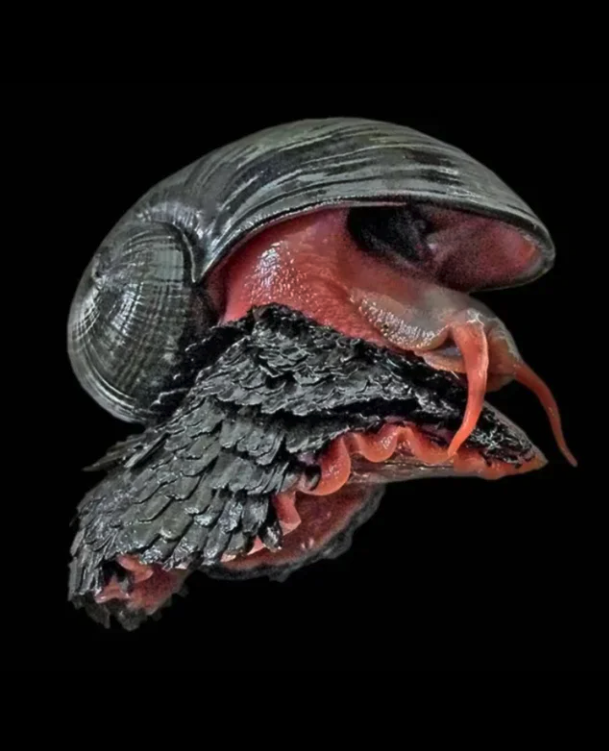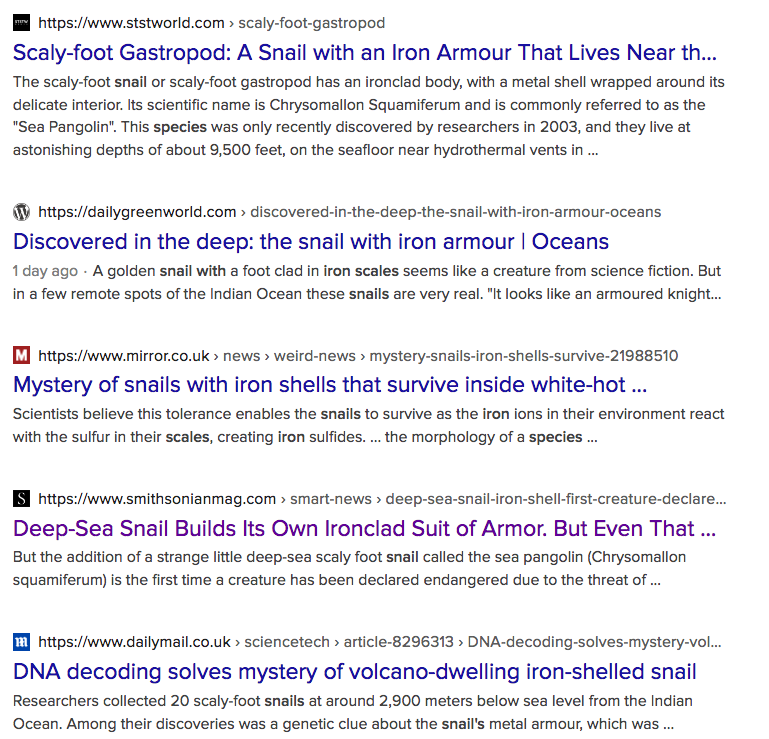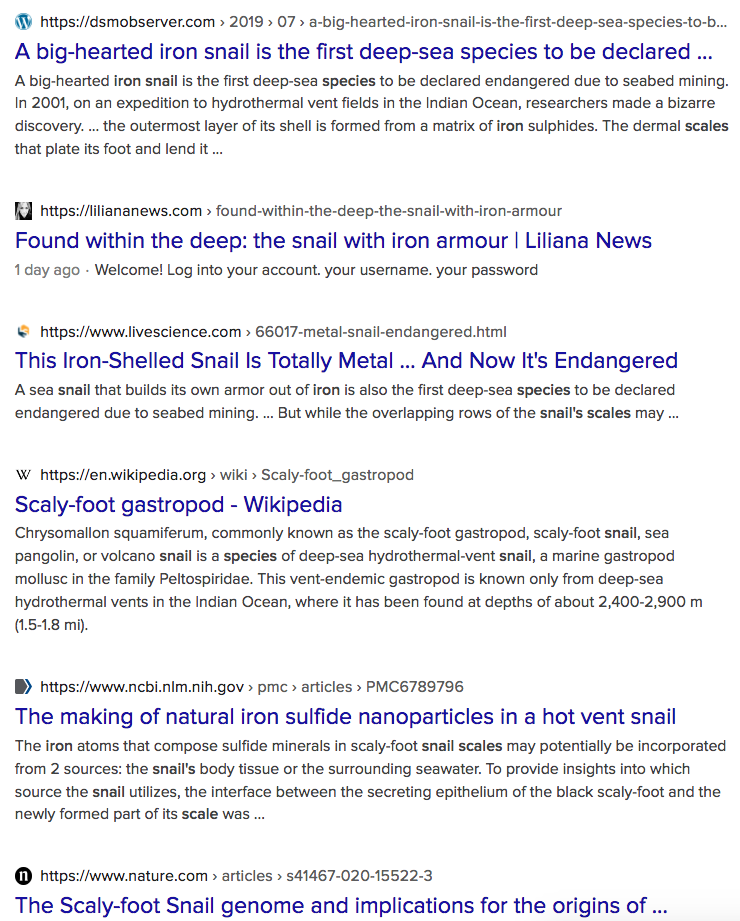It looks like you're using an Ad Blocker.
Please white-list or disable AboveTopSecret.com in your ad-blocking tool.
Thank you.
Some features of ATS will be disabled while you continue to use an ad-blocker.
18
share:
This is pretty cool, I enjoy this new feature from, the Guardian. Perhaps along with looking to the moon and Mars, we should focus some on the oceans.
Yea I know we will need to bugout out at some point or go extinct but till then let's explore our planet as fully as possible too. Besides at some
point, I believe humanity will have to live underwater for a number of potential reasons

www.theguardian.com...

www.theguardian.com...
A golden snail with a foot clad in iron scales seems like a creature from science fiction. But in a few remote spots of the Indian Ocean these snails are very real.
“It looks like an armoured knight crawling around on the deep-sea floor,” says Julia Sigwart, a biologist at Frankfurt’s Senckenberg Research Institute and one of the only people to have seen a living scaly-foot snail (Chrysomallon squamiferum), also known as a sea pangolin.
The snails’ habitat is extreme. They live several miles below the ocean surface on searing hydrothermal vents, which are bathed in toxic chemicals and can reach temperatures of more than 300C (572F).
edit on 3-8-2022 by putnam6 because: (no reason given)
a reply to: putnam6
And in the UK we struggled with 40degree heat the other week, weak ass humans
It looks like this snail is cosplaying Game of Thrones.You have gotta love these species that defy what we believe possible.
Even though this is a find of planet Earth it certainly makes life being present elsewhere in the Universe more possible, Ok it might not be little grey aliens but at least snails dont use anal probes......
And in the UK we struggled with 40degree heat the other week, weak ass humans
It looks like this snail is cosplaying Game of Thrones.You have gotta love these species that defy what we believe possible.
Even though this is a find of planet Earth it certainly makes life being present elsewhere in the Universe more possible, Ok it might not be little grey aliens but at least snails dont use anal probes......
originally posted by: UpThenDown
a reply to: putnam6
And in the UK we struggled with 40degree heat the other week, weak ass humans
It looks like this snail is cosplaying Game of Thrones.You have gotta love these species that defy what we believe possible.
Even though this is a find of planet Earth it certainly makes life being present elsewhere in the Universe more possible, Ok it might not be little grey aliens but at least snails dont use anal probes......
Yes, it does probably make life elsewhere a bit more probable. The significant point here is that the snail lives ultimately entirely off the chemical energy present in the sulfidic fluids of the hydrothermal vents being consumed by the chemoautotrophic bacteria in its gut. No photosynthesis going on here at all.
Thats incredible, an amazing adapation!
I'd like to see the French try and eat one of those!!!!
I'd like to see the French try and eat one of those!!!!
edit on 3-8-2022 by Kurokage because: (no reason given)
a reply to: putnam6
I had trouble beleiving this article.
For one thing , iron scales ? They don't rust , what ?
Another , they're " rare" but already have the name "sea pangolin " , and they're only found where " they " ( who's that? ) want to mine rare earths, at miles deep on particular volcanic vents ?
Miles deep ? What ? Are they going to do what down there , and how's that work ?
I had trouble beleiving this article.
For one thing , iron scales ? They don't rust , what ?
Another , they're " rare" but already have the name "sea pangolin " , and they're only found where " they " ( who's that? ) want to mine rare earths, at miles deep on particular volcanic vents ?
Miles deep ? What ? Are they going to do what down there , and how's that work ?
a reply to: IsabelleJones
there is more info in the linked article from OP
there is more info in the linked article from OP
The internal structure of their scales acts as tiny exhaust pipes, drawing the dangerous sulphur away from the snails’ soft tissues and depositing it as a harmless iron-based compound on the outside.
Mining firms are after the gold, silver and other precious or rare metals deposited in the rocky walls of the black smoker chimneys.
originally posted by: IsabelleJones
a reply to: putnam6
I had trouble beleiving this article.
For one thing , iron scales ? They don't rust , what ?
Another , they're " rare" but already have the name "sea pangolin " , and they're only found where " they " ( who's that? ) want to mine rare earths, at miles deep on particular volcanic vents ?
Miles deep ? What ? Are they going to do what down there , and how's that work ?
Well, I'm sorry you have trouble believing it, but most of your questions are addressed in the rest of the article.
But I got to ask why would the Guardian lie and post false info on a non-descrept snail the lives in an area smaller than St.Peters Sguare?
Makes no sense, this wouldn't drive significant sales totals for the Guardian, nor is a wide-ranging discovery ie not much prestige attached,
So what's the benefit of posting a false story, a story that we found only semi-interesting? While no doubt there are a few marine biologists who would know if this were BS or not.
It seems the Smithsonianmag is in on the ruse too, this conspiracy is deeper than even you suspected.
www.smithsonianmag.com...
as well as a host of other scientific and new sites, I guess they all could be wrong as well



edit on 4-8-2022 by putnam6 because: (no reason given)
a reply to: putnam6
Well this snail is apparently " commonly known " as a sea pangolin ,
DESPITE
Coming from a TINY AREA
THREE KILOMeTERS DOWN under the INDIAN Ocean
On a VOLCANIC VENT
But they're COMMONLY KNOWN , apparently .
Like we human come across them , EVERYDAY .
They're just sea pangolin , common you know.
Your list of links makes one ALL THE MORE suspicious.
Especially when they're talking about destroying them to exploit a lot of resources in , let's say , international waters.
You know exploitation in international waters, where's that got us all so far ?
These articles are for idiots so they can say , ah well sea pangolin , very interesting .
Busting up volcanic vents they are ( not the snails )
, where ever they feel like it.
Well thats fine , they're commonly known !?
Exploitative away why don't you ( whoever you are )
And where ever you Damn Well feel like it.
Carry on , be our guests.
We re just unquestioning fools that eat tripe at every serving . Smdh.
Well this snail is apparently " commonly known " as a sea pangolin ,
DESPITE
Coming from a TINY AREA
THREE KILOMeTERS DOWN under the INDIAN Ocean
On a VOLCANIC VENT
But they're COMMONLY KNOWN , apparently .
Like we human come across them , EVERYDAY .
They're just sea pangolin , common you know.
Your list of links makes one ALL THE MORE suspicious.
Especially when they're talking about destroying them to exploit a lot of resources in , let's say , international waters.
You know exploitation in international waters, where's that got us all so far ?
These articles are for idiots so they can say , ah well sea pangolin , very interesting .
Busting up volcanic vents they are ( not the snails )
, where ever they feel like it.
Well thats fine , they're commonly known !?
Exploitative away why don't you ( whoever you are )
And where ever you Damn Well feel like it.
Carry on , be our guests.
We re just unquestioning fools that eat tripe at every serving . Smdh.
edit on 4-8-2022 by IsabelleJones because: Correct spelling of fools
new topics
-
Winter Storm
Other Current Events: 5 minutes ago -
Biden Face Planted Somewhere
Other Current Events: 1 hours ago -
A great artist and storyteller, for kids of all ages
General Entertainment: 2 hours ago -
What Is 'Quad Demic'? Mask Mandate Returns In These US States
Diseases and Pandemics: 6 hours ago -
The Future of fashion .
Social Issues and Civil Unrest: 6 hours ago -
Bin Cyber Junk…
Short Stories: 7 hours ago -
The Undertones - Teenage Kicks
Music: 8 hours ago -
Volcano Watch 2025
Fragile Earth: 8 hours ago
top topics
-
What Is 'Quad Demic'? Mask Mandate Returns In These US States
Diseases and Pandemics: 6 hours ago, 9 flags -
The Future of fashion .
Social Issues and Civil Unrest: 6 hours ago, 6 flags -
Judge rules president-elect Donald Trump must be sentenced in 'hush money' trial
US Political Madness: 17 hours ago, 5 flags -
Volcano Watch 2025
Fragile Earth: 8 hours ago, 5 flags -
Bin Cyber Junk…
Short Stories: 7 hours ago, 5 flags -
Biden Face Planted Somewhere
Other Current Events: 1 hours ago, 3 flags -
The Undertones - Teenage Kicks
Music: 8 hours ago, 2 flags -
A great artist and storyteller, for kids of all ages
General Entertainment: 2 hours ago, 2 flags -
Winter Storm
Other Current Events: 5 minutes ago, 0 flags
active topics
-
Judge rules president-elect Donald Trump must be sentenced in 'hush money' trial
US Political Madness • 17 • : Vermilion -
Winter Storm
Other Current Events • 0 • : RickinVa -
The Why Files Lacerta Reveals the Truth of our Creation
Aliens and UFOs • 12 • : Astrocometus -
The Future of fashion .
Social Issues and Civil Unrest • 17 • : Flyingclaydisk -
Tesla Cybertruck Explodes in Front of Trump Hotel in Las Vegas
Mainstream News • 219 • : Vermilion -
Strange fog all over the northern hemisphere
General Conspiracies • 48 • : fringeofthefringe -
What Is 'Quad Demic'? Mask Mandate Returns In These US States
Diseases and Pandemics • 24 • : Flyingclaydisk -
Vehicle Strikes people in New Orleans
Mainstream News • 297 • : Flyingclaydisk -
Biden Face Planted Somewhere
Other Current Events • 5 • : Guyfriday -
NJ Drones tied to Tesla explosion at Trump Las vegas
General Conspiracies • 43 • : Flyingclaydisk
18
